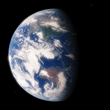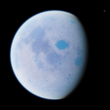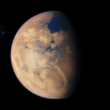
This is the hub for the Frencoverse's main canon (now in its second, improved iteration). It provides an outline of the canon and links to other information related to it.
Outline
See also: Maincanon Timeline
The Maincanon (alternatively, MC or MC2) takes place on an Earth (and wider solar system) which is, after 70 years, still recovering from the most destructive war in human history and a decade of nuclear winter. The fallout - both literal and metaphorical - is unlikely to ever disappear.
The post-war world is fundamentally changed. After very nearly perishing in the darkness of nuclear winter, civilization has made a steady return - maybe in name only, since the rural land of even the developed nations remains largely untamed - reclaimed much of the Earth. In space, the former colonies on Mars, Ceres and the Moon each went their own way.
Mutation is now a common occurence; even formerly-human mutants, such as ghouls and orks, are commonplace. Psionics is an infant science; psionic sensitivity is another mutation, though powerful human espers are very rare.
The trauma of the Great War has brought about a total civilizational shift; the old geopolitical order had been erased, and in its place new philosophies and ideals have arisen - even if, for many wastelanders, they are as basic as survival while greater powers fight overhead.
Technology
See also: Technology (Maincanon)
Technology and science still advance, but at a dramatically slower pace than they did pre-war; most practical advances have only been improvements on already-existing technology, and equipment which saw service in the Great War is not usually considered to be too obsolete.
The Earth and Solar System
The Solar System
Earth

The Earth is the origin of human civilization; though severely damaged, it still boasts a far higher population than any other body in the solar system and is the base of the vast majority of factions.
It is the only body with a surface covered primarily by water and with varying and moderate climates.
The Moon

The Moon is the first of two bodies to have undergone terraforming. It resembles a white desert and experiences high temperatures.
It is controlled in its entirety by Luna, and posesses the highest off-earth population of any body in the solar system.
Colonization began in the 1990s, and was primarily done by the US and Europe.
Mars

Mars is the second of two bodie to have been partially terraformed, though not as extensively as the Moon. It does, however, posess far larger bodies of water on its surface.
Like the Moon, Mars became independent in 2054, but did not form a united front and consequently was re-colonized after the re-emergence of major spacefaring powers.
Asteroid Belt
Colonies in the asteroid belt exist primarily as mining colonies, usually with small populations. They form no united polity and are controlled by spacefaring powers based in the Earth-Moon system.
Factions
Factions are, roughly, categorized into five "tiers" on the Influence Scale, which correspond to their geopolitical influence and capacity for power projection.
Tier I
The Tier I powers are the most powerful, possessing not only a grand global presence, but one in the stars as well. Tier One powers are typically imperialist, and are capable of managing many developed colonies across the Solar System. Tier I powers are typically indicated with space fleets, large populations, and wide-ranging influence.
The Tier I powers are:
- The New Frenco Empire
- The Astral Union of Luna
- The Mechanocracy of Russia
- The Greater Chinese Republic
- The Old Nations
Tier II
Tier II powers are still considered regional (if not somewhat global) powerhouses. Tier II powers might have some imperial influence, but are generally ill-regarded for lack of interplanetary power projection and do not (generally) posess the industrial prowess and population numbers of Tier I powers. "Rising" powers generally occupy this slot.
The Tier II powers are:
- The Commonwealth
- Austronesia
- The Pan-Caribbean Sovereignty
- Japan
Tier III
Tier III countries generally lack influence of any kind outside of their region. Many don't long for imperial glory and simply want to be left in peace. Due to their weakness and lack of influence, most are either neutral to outside Tier I and II states or seek shelter under the wings of greater powers.
The Tier III powers are:
- The Baltic Union
- Carpathia
- Iran
- Arabia
- Delhi
- The South Indian Alliance
- Maharashtra
Tier IV
Tiny, completely irrelevant states ("raider" countries, etc). These generally exist as self-recognized states of various flavors, usually existing in unstable areas (such as Central Africa, Siberia, and the rural areas of Australia and North America). Some generally exist only as "factions" against a greater power. Some exist as independent settlements with militaries numbering as low as the dozens. Tier IVs are the weakest on the Influence Scale, and are generally ignored.
Tier V
An obscure classification belonging to obscure groups. Tier Vs are regarded as "influential, but stateless". Tier IVs, depending on their goals, can become Tier Vs if their intent is not to become a state (in the case of statehood, they move up to Tier III once stability parameters are achieved). Vs are some of the hardest to keep track of, and are generally noted for their II (sometimes even I)-tier influence on certain matters.
Populations
Population numbers, after being reduced to around 20% of their pre-war levels, have generally hovered at a global population of just over 2 billion. Every area of the Earth was not equally impacted; parts of the world which were already struggling with food production suffered more severely.
The New Frenco Empire and Luna have both developed and implemented on technology capable of producing artificial humans on a large scape, while the Mechanocracy bolsters its human population with intelligent robots, and other powers maintain more conventional population growth efforts.
